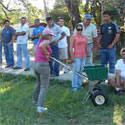Itinerario de Semana Dos
Suelos y Nutricion de las Plantas
- Hablamos de las plantas un rato
- Descanso
- Tiempo en el jardín; hablar con su grupo de ideas para su jardín. (La próxima semana van a aprender mas de diseño.) Elegir cual planta, de esas plantas que tenemos hoy, que su grupo quiere plantar esta tarde.
- Suelos
- La compactación del suelo en las obras afecta a las raíces Soil Compaction and Roots (3 pp.) (99KB pdf)
- Viven del Aire Living in Air (1 pp.) (65KB pdf)
Almuerzo
- Mas de suelos: mulch; enmiendas del suelo; compost; riego, etc.
- Approvechemos Nuestra Basura: Produzczmxo Abono Natural! Composting (23 pp. ) (1.54MB pdf)
- Técnicas Apropiadas para Aplicar el Mulch Proper Mulching Techniques (3 pp.) (216KB pdf)
- Fertilizantes
- Principios para el manejo de nutrientes en la produccion de plantas Principles of Plant Nutrition for Vegetables (3 pp.) (203KB pdf)
- Actividades afuera en el jardín: Como plantar una planta bien; aplicación de fertilizantes
- Plantación de Árboles Nuevos Planting New Trees (3 pp.)(157KB pdf)
- Indices de Fertilizantes Calculating Fertilizers (1 pp.)(66KB pdf)
Master of Gardens / Maestro del Jardin
[Commercial Audience]
Gardeners of Costa Rica / Jardineros de Costa Rica
[Community Audience]
(Same basic outlines for both classes)
1 Why Soils Are Important to Plants
- Physical and Chemical characteristics
2 Different Soil Types and Effect on Plant Growth
- Outdoor activity looking at various soils and their physical characteristics
3 Soil Amendments
- How and Why?
- Outdoor activity – mixing soil amendments in an area
4 Making Compost
- What materials to use
- How to make and maintain
- Outdoor activity making a compost pile
5 Mulches
- Benefits, What to use, How to apply, Precautions
6 Planting a Plant
- The hole
- Depth of planting
- Planting on a slope
- Mulch
- Watering
- Micro-irrigation – placement of emitters
- Problems of overhead irrigation on new plants
- Hand-watering
Discussion on Ornamentals to be Planted today
Outdoor Exercise in the Garden
- Planting shrubs and trees
- Mulching
- Installing a simple micro-irrigation system
Lunch
7 Plant Nutrition
- Major nutrients, Secondary nutrients, Micro-nutrients
8 Soil-Testing
- Typical soil test results for the area
- Typical fertilizers to use for the area
- How to soil test
- Soil test interpretation and selecting a fertilizer
9 Fertilizing
- What
- How much
- How to apply
- Spreader calibration basics
Outdoor Exercise in the Garden/Lawn
- Calibrating a lawn spreader
- Fertilizing shrubs
- Fertilizing trees
- Fertilizer bedding plants



David Marshall demonstrates how to weigh fertilizer, make settings on the spreader, and then apply a known weight of nutrients to a test plot – the steps in calibrating a Fertilizer spreader. Photos: Linda Seals, UF/IFAS
Equipment and Supplies needed
|
|
David’s Handouts in Spanish / in Adobe pdf
- Approvechemos Nuestra Basura: Produzczmxo Abono Natural! Composting (23 pp. )
- La compactación del suelo en las obras afecta a las raíces Soil Compaction and Roots (3 pp.) (99KB pdf)
- Plantación de Árboles Nuevos Planting New Trees (3 pp.) (157KB pdf)
- Indices de Fertilizantes Calculating Fertilizers (1 pp.)(66KB pdf)
- Técnicas Apropiadas para Aplicar el Mulch Proper Mulching Techniques (3 pp.) (216KB pdf)
- Principios para el manejo de nutrientes en la produccion de plantas Principles of Plant Nutrition for Vegetables (3 pp.) (203KB pdf)
- Viven del Aire Living in Air (1 pp.) (65KB pdf)